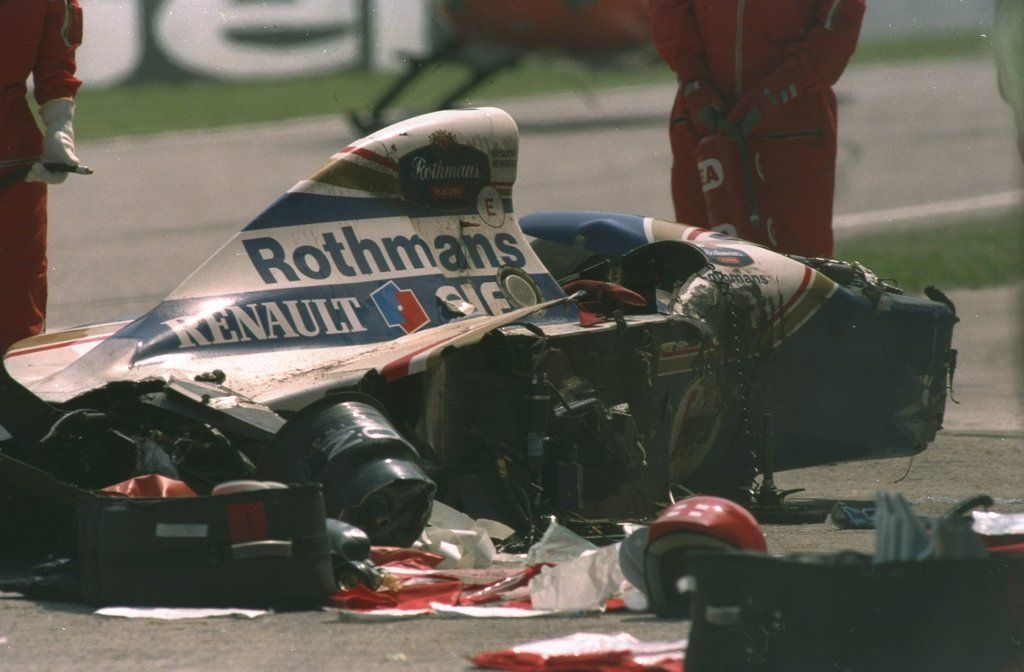The darkest racing weekend in the history of Formula 1 took place at the turn of April and May 1994. During the San Marino Grand Prix, two drivers lost their lives and one of them was the legendary Ayrton Senna. The three-time winner of the World Drivers’ Championship in one of the most prestigious racing competitions probably needs no introduction. According to many uninitiated, Ayrton was an arrogant racer, but in reality he was a hard worker who sacrificed everything, and eventually his life, to racing. Before the 1994 season, Senna transferred to the Williams team to ensure the best car on the grid. But before the start of the season, the FIA changed the rules regarding the technology used. Single-seaters were not allowed to use traction control, fully automatic transmission and, above all, active suspension. This was the greatest strength of the Williams team in the 1993 season, when their FW15C single-seater dominated the starting field and Alain Prost thanks to this and his skill won his fourth and final title in the Formula 1 championship.
Photo: Wikimedia Commons, free work
Senna was unbeatable on a wet track, although he did not like the rainy conditions himself
Before the tragic weekend in Imola, Ayrton was in a rather disadvantageous position. A new generation of racers entered, led by Michael Schumacher, who won the first two races of the season and was very aggressive after winning the championship. On the other hand, Senna did not finish a single race of the new season, and at the third Grand Prix in Imola, Italy, he was under a lot of pressure. During Friday’s practice, his compatriot Rubens Barrichello had a serious accident, flying off the track at a speed of 225 km/h. Fortunately, he escaped the accident alive with a broken nose and bruised ribs. This worried Ayrton greatly as they were good friends and Ayrton was the first person Rubens saw when he woke up from his unconsciousness. There was something dark in the air all weekend and Senna seemed out of sorts. He even greeted his biggest rival Alain Prost, who decided to retire after the 1993 season, on the team radio while driving on the track. There was a hint of sentimentality in Senna’s voice. He and Prost were at odds on and off the race track, and apparently Senna missed that rivalry.
The qualification was interrupted by a tragic event. Formula 1 rookie Roland Ratzenberger first damaged his front wing while chasing the fastest time on the track, causing him to lose downforce and crash his out-of-control car into a wall at 314km/h, apparently dead on the spot. But it was at this moment that the FIA organization headed by Max Mosley, which administers the Formula 1 championship, unknowingly played with the fate of Ayrton Senna. According to the legislation of the time, if a competitor dies directly on the track, the race must be postponed until the circumstances of the death are investigated. Senna was taken to the scene of the accident by the Safety car and saw that Ratzenberger was in very bad shape. He was criticized by the organizers for this, as they let Ratzenberger’s death be announced only after he was taken to the hospital, so that the San Marino Grand Prix could go ahead undisturbed on Sunday and the FIA would not lose millions of dollars.
Roland Ratzenberger suffered several skull fractures, including a brain hemorrhage, from which he succumbed. It was the first death of a Formula 1 pilot during a race weekend since 1982. It was also the first time that Ayrton had experienced something similar during his career in the most prestigious competition. Tears even appeared in his eyes after the tragic event. When asked by Formula 1 chief medical officer Sid Watkins if they were going to ditch the race and go fishing, Senna replied: “I can’t quit, I have to keep going”, which was his lifelong approach to motorsport. He has previously described the Formula 1 championship as a never-ending war. He was the true warrior indeed. He won qualifying for the San Marino Grand Prix, as well as qualifying for the previous two races, and once again secured the most advantageous starting position ahead of second-placed Michael Schumacher.
On the day of the race, at the drivers’ morning briefing, Senna suggested increased safety during the races and it was promised that everything would be discussed before the following Monaco Grand Prix. On Saturday during qualifying and on Sunday before the start, Ayrton still talked about safety and rule violations by the Benetton team with his biggest rival, Alain Prost, who was amazed. Previously, whenever they met, Senna didn’t even bother to say hello, and now they had a conversation of almost half an hour. By all accounts, you could say that Senna had an inkling that something bad was going to happen to him during the race. While preparing for the start of the Grand Prix, he sat on the grid in his Williams and for the first time in his Formula 1 career, he was not wearing a helmet. It was quite unusual for him and perhaps subconsciously he wanted the Championship fans to get one last look at him. Unfortunately, we will never know what was behind this decision.
Photo: Juan Pablo Donoso, flickr.com, free work
Ayrton Senna with his typically yellow helmet in his McLaren heyday
Senna took off and held the lead of the race. In the second lap, there was another serious accident involving the single-seaters of JJ Lehta and Pedro Lami, during which nothing serious happened to either of the drivers. However, a police officer and eight spectators were injured. There was dirt on the track after the accident, so the Safety car came out. In 1994 it was unusual for the Safety car to run when the track was dry. It was only the second time in history at the fateful Grand Prix of San Marino. Senna was angry with the Safety Car driver because he had to drive too slowly and the tires of his Williams cooled considerably. It was this fact that contributed to the trouble that later occurred. By the seventh lap, the race was back in full swing. Schumacher pushed from second position on Senna, who was in great form and looked like he would finally win the race.
That is, until his single-seater flew off the track at a speed of 307 km/hz in the fast Tamburello corner and crashed sideways into the wall. Part of the torn front wheel suspension went through the visor on Ayrton’s helmet and seriously injured him above his right eye. Despite prompt medical attention from the medical team, including the aforementioned Sid Watkins, and subsequent airlift to hospital, Senna died of cardiac arrest on 1 May 1994 at 18:37. Senna was clinically brain dead, so doctors decided not to revive him.
Three days of national mourning were declared in his native Brazil and Senna was given a state funeral. Around the world, people mourned the racing hero. The Williams team was investigated for the culpability of Ayrton’s death. The court found no wrongdoing on the part of the team and closed the entire tragic event with the fact that the fault was a broken steering shaft, which made the car unmanageable. This was later disproved in a documentary by National Geographic, and it was found that the problem was the car’s downforce. Before the fatal accident, sparks appeared from the back of Senna’s Williams as its floor touched the track surface. The culprit was low tire pressure, which disappeared when they cooled down by driving slowly behind the Safety Car. The ground clearance of the single-seater was reduced by a few millimeters, so Ayrton’s single-seater Williams lost downforce at the fateful moment and was uncontrollable before the Tamburello corner. Although Senna braked, he was only able to reduce the speed of his car to 207 km/h before hitting the wall.

Photo: Wikimedia Commons, free work
This is what Senna’s Williams FW16 looked like after the fatal accident
We will probably never know how it really was. However, it seems that not a human factor, nor a technical fault of the single-seater, but an incredible interplay of bad coincidences led to the death of the three-time Formula 1 world champion. It was only after this tragic death that the FIA began to address safety during the races. During the 1994 season, it made many more mistakes with the introduction of new rules, which led to further, fortunately, no longer fatal accidents. The drivers’ association was faster and had tire barriers installed in the dangerously fast sections of the tracks in Canada and Belgium. They only lasted for this season. Importantly, however, rider safety began to be addressed and many tracks, including the Tamburello corner in Imola, Italy, were modified to minimize the risk of fatal crashes. In the 30 years since the death of the great Senna, only one driver has died in an accident on the race track, which was the young Jules Bianchi in 2014.








